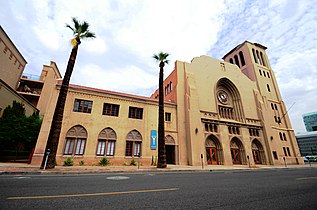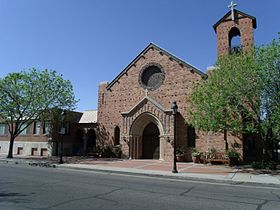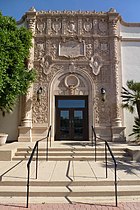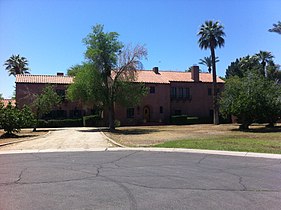American architectural firm
Fitzhugh & Byron was an architectural partnership in Phoenix, Arizona, whose partners were Lee Mason Fitzhugh (1877–1937) and Lester A. Byron (1889–1963).[1] The firm, along with architect Henry Trost in Tucson and George Washington Smith in Ajo, Arizona, is credited with the adobe style revival in the state.[2]
The firm was established in 1910, when architect Thornton Fitzhugh returned to Los Angeles, leaving his brother, Lee Fitzhugh, in change of the office. Fitzhugh & Fitzhugh, architects, was the result.[3]
A number of its works are listed on the U.S. National Register of Historic Places.[4][5]
Architectural works
- J. W. Walker Building, 10 N. 3rd Ave. & 300 W. Washington St., Phoenix (1920)
- Valley Field Riding and Polo Club, 2530 N. 64th St., Scottsdale (1924)
- Rancho Joaquina (J. E. Thompson House), 4630 E. Cheery Lynn Rd., Phoenix (1924)
- Craig Mansion, 131 E. Country Club Dr., Phoenix (1925)
- Dunbar School, 707 W. Grant St., Phoenix, (1925)
- First Church of Christ Scientist, 924 N. First St., Phoenix (1925)
- Phoenix Union Colored High School, 415 E. Grant St., Phoenix (1925–26)[6]
- Welnick Grocery Arcade, 345 W. Van Buren St., Phoenix, (1925–26)[6]
- Clark Memorial Clubhouse, 19 N. 9th St., Clarksdale (1926)
- Clarkdale High School, 849 Main St., Clarkdale (1927–28)[7]
- First Baptist Church, 302 W. Monroe St., Phoenix (1928–29)[8]
- First M. E. Church, 7102 N. 58th Dr., Glendale (1928)
- Lois Grunow Memorial Clinic, 926 E. McDowell, Phoenix (1930)
- August Grunow Residence, 124 E. Palm Ln., Phoenix (1930)
- Cline R. Asbury House, 7801 N. Central Ave., Phoenix (1934)
Gallery
References








